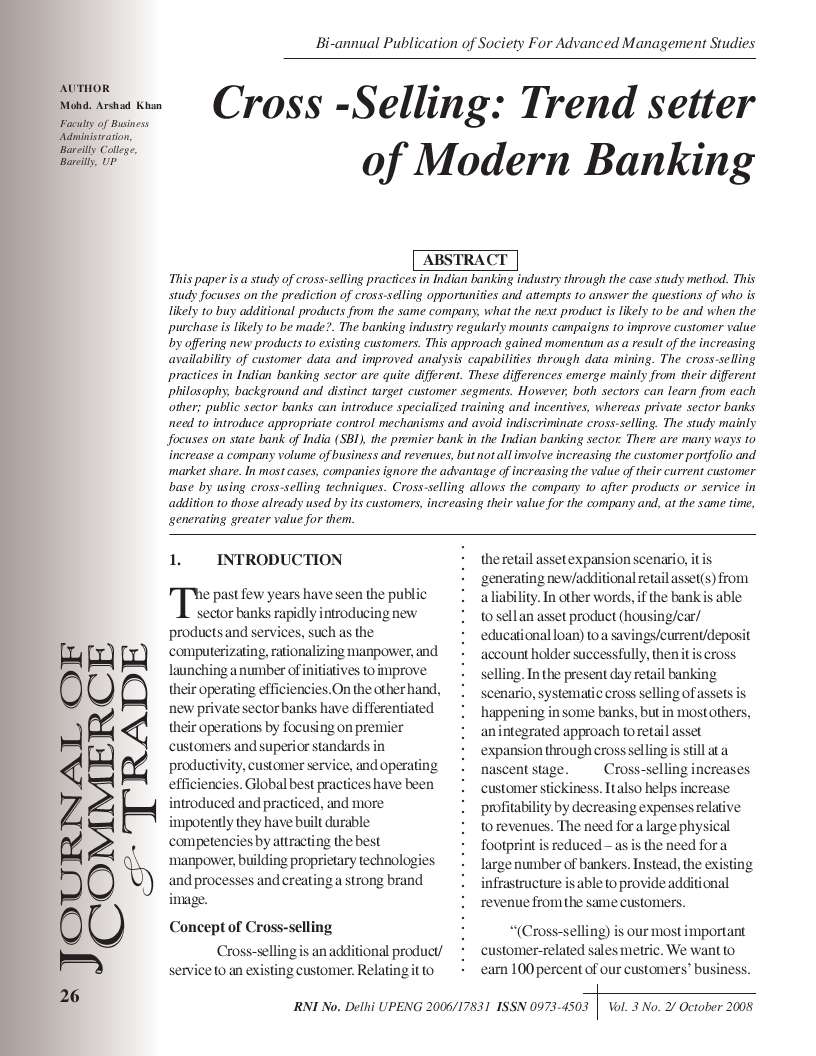Cross-Selling : Trend Setter of Modern Banking
Keywords:
Cross Selling, Trend Setter, Modern Banking, IndiaAbstract
This paper is a study of cross-selling practices in Indian banking industry through the case study method. This study focuses on the prediction of cross-selling opportunities and attempts to answer the questions of who is likely to buy additional products from the same company, what the next product is likely to be and when the purchase is likely to be made?. The banking industry regularly mounts campaigns to improve customer value by offering new products to existing customers. This approach gained momentum as a result of the increasing availability of customer data and improved analysis capabilities through data mining. The cross-selling practices in Indian banking sector are quite different. These differences emerge mainly from their different philosophy, background and distinct target customer segments. However, both sectors can learn from each other; public sector banks can introduce specialized training and incentives, whereas private sector banks need to introduce appropriate control mechanisms and avoid indiscriminate cross-selling. The study mainly focuses on state bank of India (SBI), the premier bank in the Indian banking sector. There are many ways to increase a company volume of business and revenues, but not all involve increasing the customer portfolio and market share. In most cases, companies ignore the advantage of increasing the value of their current customer base by using cross-selling techniques. Cross-selling allows the company to after products or service in addition to those already used by its customers, increasing their value for the company and, at the same time, generating greater value for them.
Downloads
Metrics
References
Anagol, Malati & Katoli, Raghavendra, “Mutual funds: just five year old and ready to run at a gallop” Economic Times, February 27, 1992.
Barua, S.K. and Verma, J.R., (1991), ‘Mastershare, A Bonanza for Large Investors’, Vikalpa, (January – March)
Dave, S.A., “Mutual Funds: Growth and Development” The Journal of the Indian Institute of Bankers, Jan-March, 1992.
De Mainak, “Mutual funds & Institutions - paying to a different tune” Economic Times, June 15, 1991.
Gordon, Natarajan, “Financial Markets and services” Himalaya publishing House.
Gupta, O.P. and Sehgal, S., (1997), ‘Investment Performance of Mutual Funds – The Indian Experience’, ‘Indian Capital Market – Trends and Dimensions’, Tata McGraw Hill Publishing Company Ltd. (on behalf of Institute of Capital Market, Navi Mumbai
Jain, P.K. (1982), ‘Financial Institution in India – A Study of Unit Trust of India’, Triveni Publication, New Delhi.
Jaydev, M., (1996), ‘Mutual Fund Performance: An Analysis of Monthly Returns’,Finance India, Vol. X, No.1, (March)
Ramola K.S., “MutuaI Fund and the Indian Capital Market” Yojana, Vol. 36, No.11, June 30, 1992.
Sharpe, W.F., “Mutual Fund Performance” Journal of Business, Vol. 39, (1966)
Shukla, S., “ Mutual funds:past performance is no indicator of the future” Economic Times, June 6, 1992,
Vyas, B.A., “Mutual funds - Boon to the Common Investors” Fortune India, July 16, 1990.
www.mutualfudsindia.com

Downloads
Published
How to Cite
Issue
Section
License
Copyright (c) 2008 Mohd. Arshad Khan

This work is licensed under a Creative Commons Attribution 4.0 International License.










